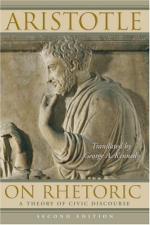
|
Book I, Chapters 1-3
1. In the beginning of the book, which one of the following did Aristotle indicate about rhetoric?
(a) It was a science.
(b) It was an art and a science.
(c) It was an art.
(d) It was neither an art nor a science.
2. According to Aristotle in Book I, Chapter 1, what was not a concern of rhetoric?
(a) A vague subject.
(b) An academic subject.
(c) A specific subject.
(d) A hypothetical subject.
3. What type of argumentation did Aristotle think the dialectic should be associated with?
(a) Proper and valid.
(b) Simple and valid.
(c) Proper, simple, and valid.
(d) Proper and simple.
4. As Aristotle explained, in which situations would rhetoric be useful?
(a) Situations where dialectic would also be appropriate.
(b) Situations where dialectic would be misunderstood.
(c) Situations where dialectic would be understood.
(d) Situations where dialectic would be inappropriate.
5. How did Aristotle think rhetoric could be useful in terms of one's beliefs?
(a) Confirmation.
(b) Explanation.
(c) Expansion.
(d) Refinement.
(read all 180 Multiple Choice Questions and Answers)
|
This section contains 5,929 words (approx. 20 pages at 300 words per page) |

|




